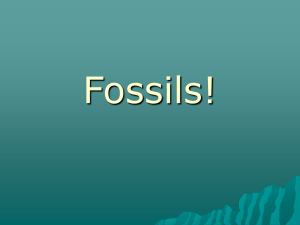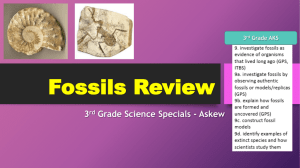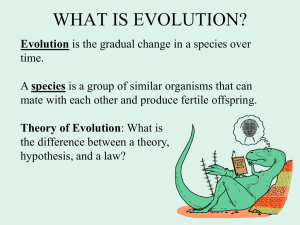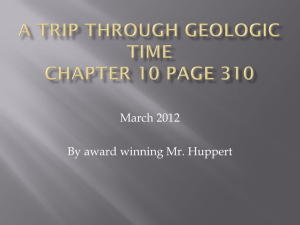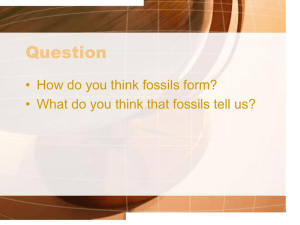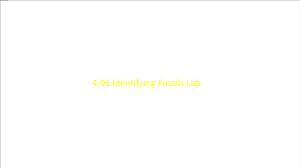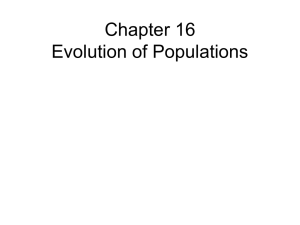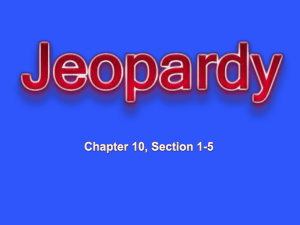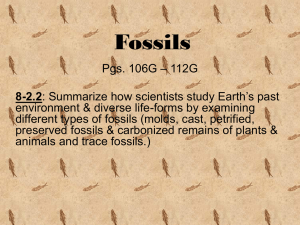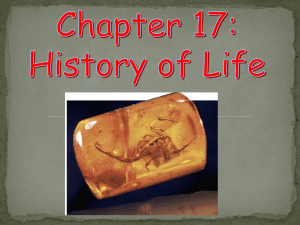Fossils - MrsBlochScience
advertisement
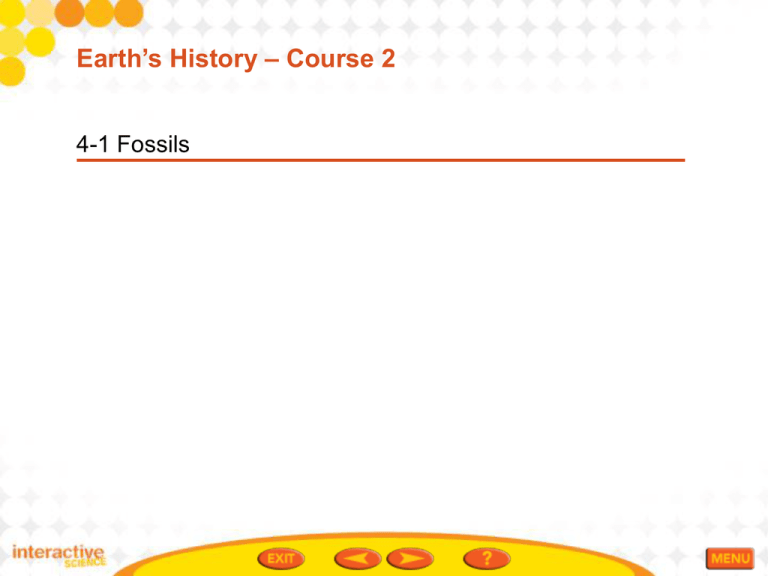
Earth’s History – Course 2 4-1 Fossils My Planet Diary pg. 140 A Dinosaur Named Sue On a hot day in August 1990, Sue Hendrickson was hunting for fossils near the town of Faith, South Dakota. She found some little pieces of bone below a cliff. When she looked up at the cliff, she saw more bones. These bones weren’t little. They were enormous! She and other scientists determined that they were the bones of a Tyrannosaurus rex. In fact, she’d found the largest and most complete skeleton of a Tyrannosaurus ever discovered. Today, the skeleton, nicknamed “Sue,” is on display at the Field Museum in Chicago. 1. What science skills did Sue Hendrickson use when she discovered Sue ? __________________________________________________ 2. What do you think scientists can learn by studying dinosaur skeletons? __________________________________________________________ What are Fossils? Pg. 141 Fossils are preserved remains or traces of living things. Most fossils form when living things die and are buried by sediment. The sediment slowly hardens into rock and preserves the shapes of the organisms. Sediment is made up of rock particles or the remains of living things. How a Fossil Forms: A fossil may form when sediment quickly covers an organism’s body. Assess Your Understanding pg. 141 I get it! Now I know that fossils are _______________________ ___________________________________________________ What are the Kinds of Fossils? Pg. 142 Fossils found in rock include: molds and casts: A mold is a hollow area in sediment in the shape of an organism or part of an organism. A cast is a solid copy of the shape of an organism. petrified fossils: minerals have replaced part or all of an organism. carbon films: an extremely thin coating of carbon on a fossil that preserves the delicate parts of plant leaves and insects. trace fossils: such as footprints provide evidence of the activities of ancient organisms. Preserved Remains: when the remains of organisms are preserved in substances such as tar, amber, or ice. HOW IS A FOSSIL FORMED? 1. Sediment An animal is buried by sediment, such as volcanic ash or silt, shortly after it dies. Its bones are protected from rotting by the layer of sediment. 2. Layers 3. Movement More sediment layers accumulate above the animal’s remains, and minerals, such as silica (a compound of silicon and oxygen), slowly replace the calcium phosphate in the bones. Movement of tectonic plates, or giant rock slabs that make up Earth’s surface, lifts up the sediments and pushes the fossil closer to the surface. 4. Erosion Erosion from rain, rivers, and wind wears away the remaining rock layers. Eventually, erosion or people digging for fossils will expose the preserved remains. FIVE MAIN TYPES OF FOSSILS Petrified Fossils Molds and Casts Trace Fossils Carbon Films Preserved Remains PETRIFIED FOSSILS • The word “petrified” means “turning into stone.” • Petrified fossils form when minerals replace all or part of an organism. PETRIFIED FOSSIL The Field Museum in Chicago displays a fossil of a Tyrannosaurus rex. • Water is full of dissolved minerals. It seeps through the layers of sediment to reach the dead organism. When the water evaporates, only the hardened minerals are left behind. MOLDS AND CASTS • A mold forms when hard parts of an organism are buried in sediment, such as sand, silt, or clay. MOLD FOSSIL This mold, or imprint, is of an extinct mollusk called an ammonite. • The hard parts completely dissolve over time, leaving behind a hollow area with the organism’s shape. • A cast forms as the result of a mold. • Water with dissolved minerals and sediment fills the mold’s empty spaces. CAST FOSSIL This ammonite cast was discovered in the United Kingdom. • Minerals and sediment that are left in the mold make a cast. • A cast is the opposite of its mold. CARBON FILMS • All living things contain an element called carbon. • When an organism dies and is buried in sediment, the materials that make up the organism break down. FERN FOSSIL This carbon-film fossil of a fern is more than 300 million years old. • Eventually, only carbon remains. • The thin layer of carbon left behind can show an organism’s delicate parts, like leaves on a plant. TRACE FOSSILS • Trace fossils show the activities of organisms. • An animal makes a footprint when it steps in sand or mud. FANCY FOOTWORK This dinosaur footprint was found in Namibia, Africa. • Over time the footprint is buried in layers of sediment. Then, the sediment becomes solid rock. PRESERVED REMAINS Some organisms get preserved in or close to their original states. Here are some ways that can happen. Amber Tar Ice An organism, such as an insect, is trapped in a tree’s sticky resin and dies. More resin covers it, sealing the insect inside. It hardens into amber. An organism, such as a mammoth, is trapped in a tar pit and dies. The tar soaks into its bones and stops the bones from decaying. An organism, such as a woolly mammoth, dies in a very cold region. Its body is frozen in ice, which preserves the organism—even its hair! Video: Becoming a Fossil For more on fossils visit: http://www.pbs.org/wgbh/evolution/library/04/3/l_043_0 1.html PBS Article: Major Fossil Find http://www2.scholastic.com/browse/article.jsp?id=3751 945 Scholastic News Online Online Exhibit: Fossil Halls http://www.amnh.org/exhibitions/permanent/fossilhalls American Museum of Natural History Interactive Game: Fossil Hunt http://channel.nationalgeographic.com/episode/dinodeath-trap-2998#tab-fossil-hunt Scholastic Classroom Magazines. www.scholastic.com Photo Credits: PAGE 1: UTAH MUSEUM OF NATURAL HISTORY (DINOSAUR); PHOTOTAKE INC./ALAMY (ANT). PAGE 3: 5W INFORGRAPHIC (GRAPHIC). PAGE 4: Jason Lindsey/Alamy (DINOSAUR); Peter Bowater/Alamy (MOLD); David Lyons/Alamy (FERN); Hoberman Collection UK/Alamy (FOOTPRINT); John Cancalosi/Alamy (MANTIS). PAGE 5: Gary Crabbe/Alamy (DINOSAUR). PAGE 6: Peter Bowater/Alamy (MOLD); Detail Heritage/Alamy (CAST). PAGE 7: David Lyons/Alamy (FERN). PAGE 8: Hoberman Collection UK/Alamy (FOOTPRINT). PAGE 9: John Cancalosi/Alamy (MANTIS); R1/Alamy (TAR PITS); Gianni Dagli Orti/Corbis (MAMMOTH). National Geographic Assess Your Understanding pg. 143 1a. Identify A (mold / trace fossil) can form when sediment buries the hard part of an organism. b. Explain A petrified fossil forms when _________________ replace parts of a(n) _________________________. c. Make Generalizations What might you learn from a carbon film that you could not learn from a cast? ___________________________________________________ I get it! Now I know that the kinds of fossils are ______________ ___________________________________________________ What Do Fossils Show? Pg. 144 A paleontologist is a scientist who studies fossils. The fossil record is the combined information about fossils collected by scientists throughout history. •It provides evidence about the history of life and past environments on Earth. • It also shows how different groups of organisms have changed over time. The term evolution is used to identify the process of gradual change in living things over long periods. A type of organism is extinct if it no longer exists and will never again live on Earth. Fossils – Figure 3 pg. 144 Wyoming, 50 Million Years Ago Today, Wyoming has areas of dry plateaus, but 50 million years ago it was very different. Infer- Identify the organism or kind of organism shown by fossils a, b, and c. Challenge What features of Hyracotherium show that it is related to horses? Assess Your Understanding pg. 145 2a. Explain What does the fossil record show about how life has changed over time? ___________________________________ ___________________________________________________ b. Apply Concepts Give an example of a question you could ask about a fossil of an extinct organism. _____________________ ___________________________________________________ ___________________________________________________ I get it! Now I know that the fossil record shows _____________ ___________________________________________________
